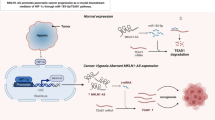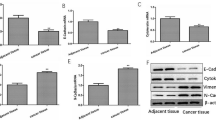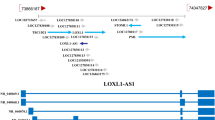Abstract
Breast cancer has become the most leading diagnosed tumor worldwide in 2020. In this study, the biomarker potential and influence on the cellular function of lncRNA PPP1R26-AS1 was investigated in breast cancer. Expression levels of lncRNA PPP1R26-AS1 in breast tissues and cells were detected by RT-qPCR. Association between lncRNA PPP1R26-AS1 level and clinical parameters was investigated by Chi-square analysis. The prognostic potential was assessed by Kaplan–Meier and multivariate Cox regression analysis. Knockdown of lncRNA PPP1R26-AS1 was subjected to study the effect on cell proliferation, invasion, and migration by CCK-8 and transwell assay. The bind between PPP1R26-AS1 and miR-1226-3p was investigated. LncRNA PPP1R26-AS1 was highly expressed in breast tissues and cell lines. This upregulation was correlated with pTNM, positive ER status, luminal B subtype, positive nodal status, and shorter overall survival in breast cancer patients. Significant decreases in proliferation, migration, and invasion activity were observed upon knockdown of lncRNA PPP1R26-AS1. lncRNA PPP1R26-AS1 could act as ceRNA to bind with miR-1226-3p in breast cancer. LncRNA PPP1R26-AS1, as oncogenic lncRNA, could provide a new perspective on the development of prognostic biomarkers and a new approach in tailoring the treatment personalized in breast cancer.





Similar content being viewed by others
Data Availability
The datasets used and/or analyzed during the current study are available from the corresponding author on reasonable request.
References
DeSantis, C. E., Ma, J., Gaudet, M. M., Newman, L. A., Miller, K. D., Goding Sauer, A., et al. (2019). Breast cancer statistics. A Cancer Journal for Clinicians, 69, 438–51.
Ahmad, A. (2019). Breast cancer statistics: Recent trends. Advances in Experimental Medicine and Biology, 1152, 1–7.
Cao, W., Chen, H. D., Yu, Y. W., Li, N., & Chen, W. Q. (2021). Changing profiles of cancer burden worldwide and in China: A secondary analysis of the global cancer statistics 2020. Chinese Medical Journal (Engl), 134, 783–791.
Azamjah, N., Soltan-Zadeh, Y., & Zayeri, F. (2019). Global trend of breast cancer mortality rate: A 25-year study. Asian Pacific Journal of Cancer Prevention, 20, 2015–2020.
Xie, Y., Valdimarsdóttir, U. A., Wang, C., Zhong, X., Gou, Q., Zheng, H., et al. (2021). Public health insurance and cancer-specific mortality risk among patients with breast cancer: A prospective cohort study in China. International Journal of Cancer, 148, 28–37.
Nagini, S. (2017). Breast cancer: Current molecular therapeutic targets and new players. Anti-Cancer Agents in Medicinal Chemistry, 17, 152–163.
Waks, A. G., & Winer, E. P. (2019). Breast cancer treatment: A review. JAMA, 321, 288–300.
Tsang, J. Y. S., & Tse, G. M. (2020). Molecular classification of breast cancer. Advances in Anatomic Pathology, 27, 27–35.
Howlader, N., Cronin, K. A., Kurian, A. W., & Andridge, R. (2018). Differences in breast cancer survival by molecular subtypes in the United States. Cancer Epidemiology, Biomarkers & Prevention, 27, 619–626.
Johansson, A. L. V., Trewin, C. B., Hjerkind, K. V., Ellingjord-Dale, M., Johannesen, T. B., & Ursin, G. (2019). Breast cancer-specific survival by clinical subtype after 7 years follow-up of young and elderly women in a nationwide cohort. International Journal of Cancer, 144, 1251–1261.
Li, G., Hu, J., & Hu, G. (2017). Biomarker studies in early detection and prognosis of breast cancer. Advances in Experimental Medicine and Biology, 1026, 27–39.
Barzaman, K., Karami, J., Zarei, Z., Hosseinzadeh, A., Kazemi, M. H., Moradi-Kalbolandi, S., et al. (2020). Breast cancer: Biology, biomarkers, and treatments. International Immunopharmacology, 84, 106–535.
Dumitrescu, R. G. (2018). Early epigenetic markers for precision medicine. Methods in Molecular Biology, 1856, 3–17.
Shi, S. H., Jiang, J., Sun, L., Zhang, W., & Zhuang, Z. G. (2020). Dynamic regulative biomarker: Long noncoding RNA (lncRNA) in metastatic breast cancer. Clinical Laboratory. https://doi.org/10.7754/Clin.Lab.2020.191140
Vikram, R., Ramachandran, R., & Abdul, K. S. (2014). Functional significance of long non-coding RNAs in breast cancer. Breast Cancer, 21, 515–521.
Feng, Y., Wu, M., Hu, S., Peng, X., & Chen, F. (2020). LncRNA DDX11-AS1: A novel oncogene in human cancer. Human Cell, 33, 946–953.
Buccarelli, M., Lulli, V., Giuliani, A., Signore, M., Martini, M., D’Alessandris, Q. G., et al. (2020). Deregulated expression of the imprinted DLK1-DIO3 region in glioblastoma stemlike cells: Tumor suppressor role of lncRNA MEG3. Neuro-Oncology, 22, 1771–1784.
Venkatesh, J., Wasson, M. D., Brown, J. M., Fernando, W., & Marcato, P. (2021). LncRNA-miRNA axes in breast cancer: Novel points of interaction for strategic attack. Cancer Letters, 509, 81–88.
Zhang, X., Sun, X. F., Cao, Y., Ye, B., Peng, Q., Liu, X., et al. (2018). CBD: A biomarker database for colorectal cancer. Database (Oxford), 2018, bay046.
Xu, S., Kong, D., Chen, Q., Ping, Y., & Pang, D. (2017). Oncogenic long noncoding RNA landscape in breast cancer. Molecular Cancer, 16, 129.
Goldhirsch, A., Wood, W. C., Coates, A. S., Gelber, R. D., Thürlimann, B., & Senn, H. J. (2011). Strategies for subtypes: Dealing with the diversity of breast cancer: Highlights of the St. Gallen International Expert Consensus on the Primary Therapy of Early Breast Cancer 2011. Annals of Oncology, 22, 1736–1747.
Yoon, S. H., Kim, H. S., Kim, R. N., Jung, S. Y., Hong, B. S., Kang, E. J., et al. (2020). NAD(P)-dependent steroid dehydrogenase-like is involved in breast cancer cell growth and metastasis. BMC Cancer, 20, 375.
Zhang, L., Chi, B., Chai, J., Qin, L., Zhang, G., Hua, P., et al. (2021). LncRNA CCDC144NL-AS1 serves as a prognosis biomarker for non-small cell lung cancer and promotes cellular function by targeting miR-490-3p. Molecular Biotechnology, 63, 933–940.
Fahad, U. M. (2019). Breast cancer: Current perspectives on the disease status. Advances in Experimental Medicine and Biology, 1152, 51–64.
Prat, A., Pineda, E., Adamo, B., Galván, P., Fernández, A., Gaba, L., et al. (2015). Clinical implications of the intrinsic molecular subtypes of breast cancer. Breast, 24(Suppl 2), S26-35.
Vuong, D., Simpson, P. T., Green, B., Cummings, M. C., & Lakhani, S. R. (2014). Molecular classification of breast cancer. Virchows Archiv, 465, 1–14.
Odle, T. G. (2017). Precision medicine in breast cancer. Radiologic Technology, 88, 401m-m421.
Bao, X., Anastasov, N., Wang, Y., & Rosemann, M. (2019). A novel epigenetic signature for overall survival prediction in patients with breast cancer. Journal of Translational Medicine, 17, 380.
Markopoulos, C., van de Velde, C., Zarca, D., Ozmen, V., & Masetti, R. (2017). Clinical evidence supporting genomic tests in early breast cancer: Do all genomic tests provide the same information? European Journal of Surgical Oncology, 43, 909–920.
Zheng, X., Wang, X., Zheng, L., Zhao, H., Li, W., Wang, B., et al. (2020). Construction and analysis of the tumor-specific mRNA–miRNA–lncRNA network in gastric cancer. Frontiers in Pharmacology, 11, 1112.
Tee, A. E., Liu, B., Song, R., Li, J., Pasquier, E., Cheung, B. B., et al. (2016). The long noncoding RNA MALAT1 promotes tumor-driven angiogenesis by up-regulating pro-angiogenic gene expression. Oncotarget, 7, 8663–8675.
Chan, J. J., & Tay, Y. (2018). Noncoding RNA:RNA regulatory networks in cancer. International Journal of Molecular Science, 19, 1310.
Mohamadzade, Z., et al. (2021). Cell specific tumor suppressor effect of Hsa-miR-1226-3p through downregulation of HER2, PIK3R2, and AKT1 genes. International Journal of Biochemistry & Cell Biology, 134, 105965.
Author information
Authors and Affiliations
Corresponding author
Additional information
Publisher's Note
Springer Nature remains neutral with regard to jurisdictional claims in published maps and institutional affiliations.
Rights and permissions
About this article
Cite this article
Zhou, S., Zhang, S., Zhang, H. et al. Clinical Potential of lncRNA PPP1R26-AS1 in Breast Cancer and Its Contribution to Cancer Progression. Mol Biotechnol 64, 660–669 (2022). https://doi.org/10.1007/s12033-022-00452-w
Received:
Accepted:
Published:
Issue Date:
DOI: https://doi.org/10.1007/s12033-022-00452-w




